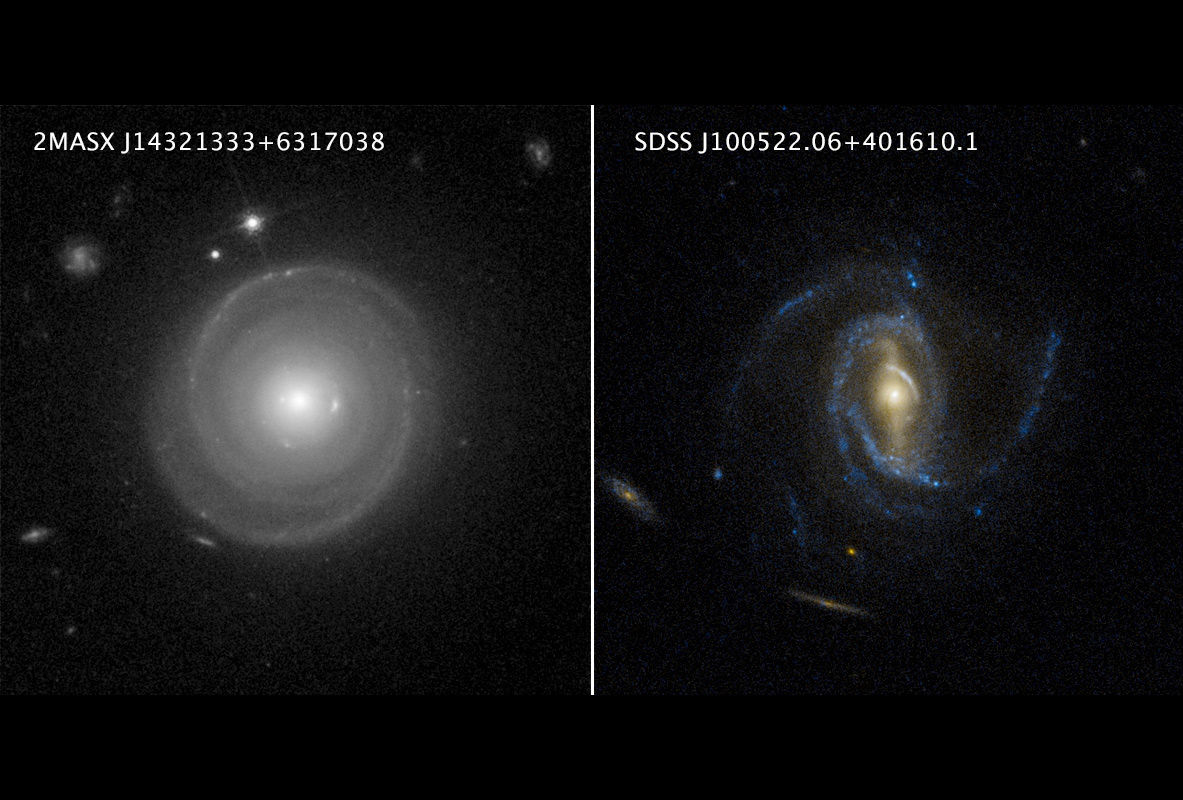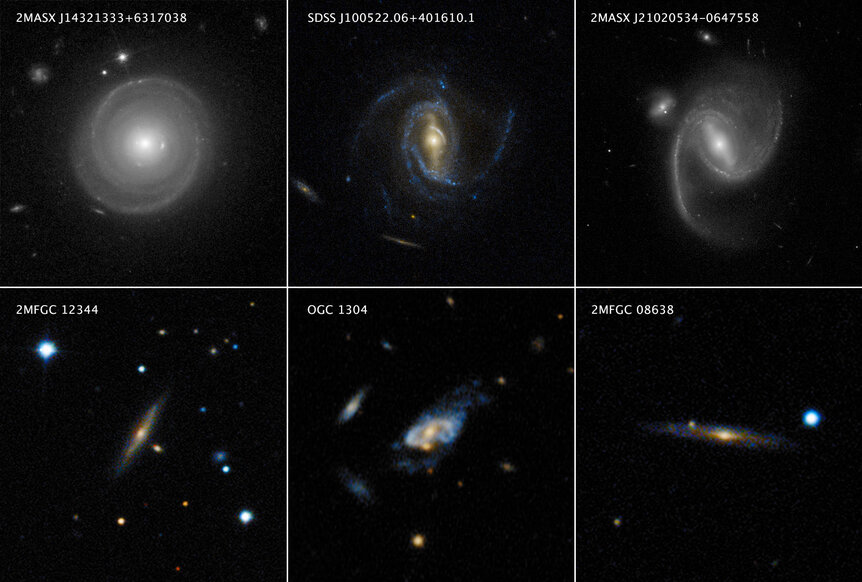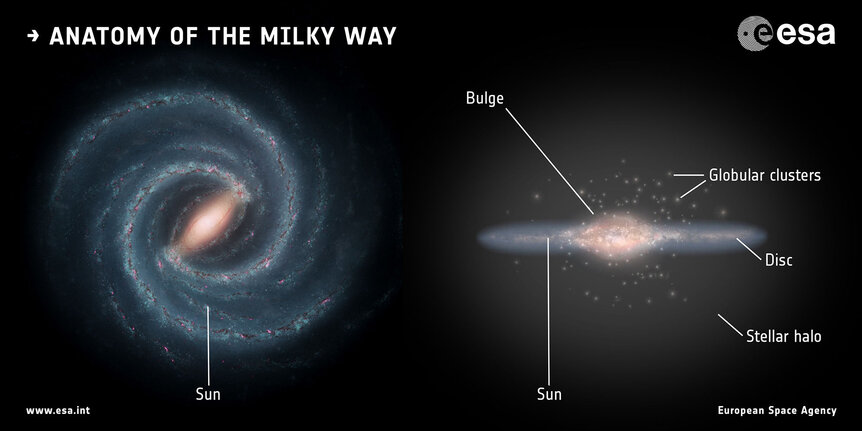Create a free profile to get unlimited access to exclusive videos, sweepstakes, and more!
Super spiral galaxies are huge and bright… and spin *really* rapidly

As I’ve mentioned more than once here on the blog, spiral galaxies have a number of components: a flat disk with spiral arms, a central bulge of old stars, a halo surrounding them of old stars, and a bigger halo of dark matter (the invisible stuff that we know exists due to its gravity, which influences the galaxy inside it).
Spirals come in many sizes, too. The Milky Way, our home galaxy, is 100,000 or so light years across. There’s not a clean cutoff; it’s not like there’s a sign that says "end of galaxy" 50,000 light years from the center. Some stars have been detected farther out, but the disk kinda fades into the halo out there.
Many spirals are smaller, half the size of ours. The Large Magellanic Cloud, a satellite companion to the Milky Way, is about 30,000 light years across, and is vaguely spiral.
The Milky Way is big for a galaxy… but there are some that are bigger. A lot bigger.
Like, a whole lot bigger. Seriously, reading this paper about them had me muttering “holy crap” over and again.
These galaxies are called super spirals, and a survey of 53 of them shows they run from 180,000 to 440,000 light years across. They are incredibly luminous, too, giving off as much as 20 times more energy as the Milky Way (found, basically, by adding up all the energy emitted by stars). Their stellar masses (literally the total mass of just stars) run from about three time the mass of the Milky Way up to a staggering 10 times as much. They also make stars a lot faster than the Milky Way does, from twice to up to 40 times the rate as our galaxy. These are ridiculously huge, bright, massive galaxies.
A new paper has come out where a team of astronomers measured how rapidly the galaxies are rotating — the stars, gas, and dust orbit the center of the galaxy, and this can be measured by taking a spectrum of the galaxy and measuring the Doppler shift of the light. What they found is that these galaxies rotate really quickly: one was clocked at a speed of 570 kilometers per second. That’s incredible. The Sun orbits the center of the Milky Way at about 200 kps, so this one galaxy has stars in it moving nearly three times faster.
This is way faster than expected! The speed a star moves in its orbit depends on the total mass of the galaxy and also how it’s distributed. In general, the more mass, the faster the star moves. The astronomer Vera Rubin discovered that galaxy rotation curves (a graph showing how rapidly stars in a galaxy move versus their distance from the center) flatten out with distance, when you’d expect them to drop. She posited that galaxies were surrounded by huge haloes of matter we can’t see, which contributed to the overall gravitational field of the galaxy. We now know this to be true; dark matter makes up a substantial fraction of the matter in the Universe, and galaxies do have haloes of them. We can’t see them directly, but we can measure their effects quite well.
Accounting for the mass of the galaxies made up by normal matter (stars, gas, and so on), the astronomers could calculate how much dark matter is in the haloes of these super spirals, and this is where my jaw truly slammed down onto my desk: The largest of these galaxies, 2MFGC 08638, has a dark matter halo equivalent to — and I can hardly believe I’m writing this — 40 trillion times the mass of the Sun.
Forty. Trillion.
I read that and I think my brain leapt out of my skull and started running around in tight panicky circles. That’s a vast amount of mass. Colossal. A halo that size and mass would normally enclose a cluster of galaxies, not just one.
And that’s interesting. Given that massive a halo, that one galaxy is actually undermassive in stars; you’d expect it to have far more stars in it for a halo like that. That turns out to be the case for a lot of these galaxies. Why?
It’s possible that when a galaxy has a halo that large, it makes star formation early on (when the galaxy is very young) harder. That huge rotation rate may make it harder for gas clouds to collapse against the larger centrifugal force. Another possibility is that the big mass means that when galaxies try to draw in gas to make stars, the gas is moving so rapidly under the extra gravity that it heats up too much to collapse and actually form stars. This apparently isn’t as big a deal now, billions of years later, since the galaxies are cranking out stars fecundantly* now.
There’s a well-known guideline in astronomy called the Tully-Fischer relation, which says that the rotation rate of a galaxy is related to its luminosity; the brighter it is, the more massive it’s likely to be (that is, it has more stars), and so it spins faster. This new result shows that at the high-mass end this doesn’t work. The dark matter halo gets so big that it blows the curve.
I love this. Love it. We’ve known about galaxies for about a century now, but with the advent of bigger and more sophisticated telescopes, better imaging techniques, and a better understanding of how galaxies work, we’re finding whole new classifications of them!
Whenever I read something like this, it always makes me wonder: What else is there, out in the black, that is just barely invisible to our current methods of observations, just waiting for the next step in our ability to see the sky better?
*I know that’s not a word, but give me a break; I’ve only just been able to get my brain stuffed back into my skull after reading about all this.




























